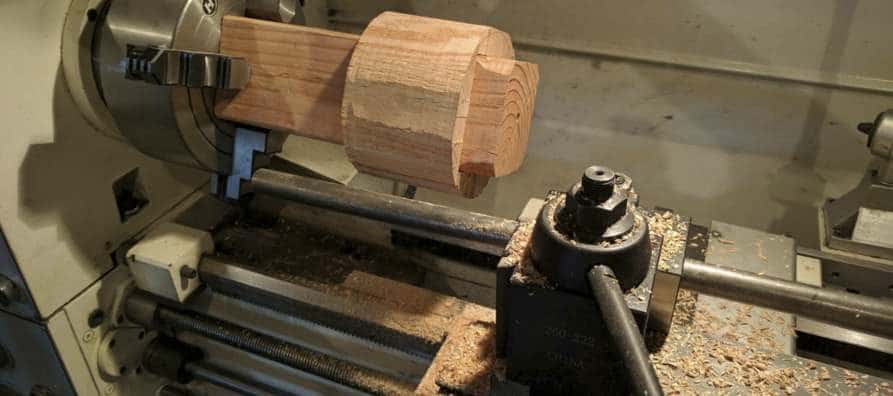Disclaimer: As an Amazon affiliate, I may earn a small percentage from qualifying purchases. This is at no extra cost to you. Learn more here.
The simple answer is yes. You can turn wood on a metal lathe.
However, you should not attempt to turn metal on a wood lathe. Using a wood lathe to turn metal may result in ‘chatter.’ Which means the vibration on your workpiece, which will leave ridged or rough surface on it.
A lathe is an excellent machining tool that will help you shaping wood, metal, and a variety of other materials.
What it does, it holds a work-piece then rotates it to give any desired shape by performing different cutting methods.
In general, you will get two options for a lathe in the market to work with two different kinds of materials- wood and metal.
Turning wood on a regular mini metal lathe makes more sense than turning metal on a wood lathe even if it’s the finest one.
How to Turn Wood on a Metal Lathe?

The turning process basically would be the same way as turning a wood piece on a wood lathe.
1. Place your wooden workpiece on the lathe.
2. Begin by tracing a profile.
3. Increase the speed for turning after the profile has been traced.
4. The surface may turn out to be rough, but sanding the work will fix it.
5. When you’re done sanding the wood, drill it with a 3/4″ router bit
6. Then use a 1″ router bit.
Now, let’s talk about the advantages and disadvantages of turning wood on a metal lathe.
Advantages of Turning Wood on A Metal Lathe
- One advantage metal lathe has over wood lathe is that it’s sturdier and hence enable you to handle unsteady wood pieces with less vibration.
- Metal lathes are the better option if you want to turn the wood piece into a cylindrical shape with precise dimensions. Usually, the tailstock and headstock of a metal lathe tend to have a better alignment along with a strong quill.
- They are also able to drill and then can pierce a hole to your desired diameter. Since they can penetrate the diameter consistently you can easily produce identical lengths and diameters.
- While working with unsteady wooden pieces, metal lathes are better because they maintain a slower speed as opposed to wood lathes. The metal lathes that come with back-gear will allow lower speeds.
- Sturdier balance along with its power feed-in its carriage, metal lathes will also help you to turn long wood pieces.
Disadvantages of Turning Wood on A Metal Lathe
- If you’re looking to turn curved wood shapes, then metal lathes aren’t the one to go for.
- Tool-post for metal lathes require custom design.
- Top speed of metal lathes may not cater to specific tasks.
- When you use a metal lathe to turn wood, the leftover shavings from the wood may cause damage to the bed, carriage, and left slide to the metal.
- Many wood lathes are capable of turning a larger diameter than metal lathes.
Can You Turn Metal on a Wood Lathe?
Turning metal on a wood lathe is a recipe for disaster. Doing so will likely damage your lathe. Furthermore, it will probably cause lathe chatter, resulting in a low-quality finished product. There are exceptions, however. Soft metals like copper and brass can be turned at slow speeds.
Additional Reminders
It is good to understand that wood lathes are particularly made for turning wood. Although you can use metal lathes to turn wood, you also need to remember that low-priced wood lathes are capable of working with much bigger stock than cheap metal lathes.
Metal lathes require a fast and thorough cleaning after the wood is turned on it. This is due to the fact that metal lathes count on close tolerances and adequately machined surfaces. So, the dust and shavings from the wood may lead it to corrode easily.
This version of a lathe is not properly equipped to make bowls, or cups or difficult moldings and require modifications. Both of these lathes usually have different turning processes.
The cutters installed in a metal lathe are unable to produce satisfactory results in wood surfaces and you need additional time and effort to sand the workpiece. The techniques differ too so you cannot just use a piece of wood as you would with metal and work on a metal lathe.
One way to make this process work and turn wood on a metal lathe is that you can use a big bar of steel in the tool holder, replacing the tool and utilize it as a firm rest for more traditional woodturning tools.
Conclusion
We hope this article answers all your queries about turning wood using metal lathes. Nevertheless, we’d like to part with a piece of advice for you; Always make sure to clean your metal lathes using a shop vac instead of compressed air if you choose to go ahead with turning wood using metal lathes.
P.S. Want a great shop vac? Here’s the one I use on Amazon.
